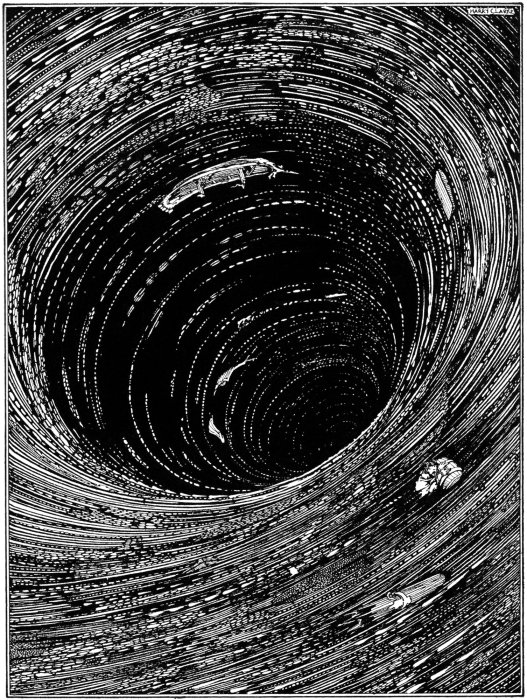“M.S. Found in a Bottle:” A Look at Poe’s Skepticism of 19th-Century Science, Part II
Murray Ellison | August 31, 2017
By being unobserved, the unnamed narrator of Poe’s, “M.S. Found in a Bottle” is looking at the relics of science on the ship he is standing on as an outsider. He concludes that much of nineteenth-century science is outdated and largely based on theories of misguided scientists like Francis Bacon and Symmes. He describes the ship as having a “severely simple bow and antiquated stern,” that reminds him of “an unaccountable memory of old foreign chronicles and ages long ago.” The captain’s “gray hairs are records of the past, and his grayer eyes are Sybils of the future. A Sybil is a witch or a harbinger of dark and dangerous times. The narrator observes that the “cabin floor was thickly strewn with strange, iron clasped folios, moldering instruments of science and obsolete long-forgotten charts” (144). Poe believed that the tools of nineteenth-century science could not chart a course to the future and that the captain is sailing to an unknown destination and using outdated maps. The narrator’s assumptions about the inadequacies of the ship are confirmed as the journey reaches the frightening abyss Symmes imagined at the South Pole. Poe exploits and, perhaps satirizes Symmes’s theories and the fears that readers associated with such beliefs when the narrator encounters the Pole’s vortex:
Oh, horror upon horror!—the ice opens up to the right, and to the left, and suddenly we are whirling dizzily, in immense concentric circles, round and round, the borders of a gigantic amphitheater, the summit of those walls is lost in the darkness and the distance. But little time will be left me to ponder upon my destiny! The circles grow small—we are plunging madly within the grasp of the whirlpool—amid a roaring… and thundering of ocean and of the tempest, the ship is quivering—oh God! And—going down (146).
Poe uses the phrase, “whirling dizzily,” to show that those who believe in the systems of nineteenth-century science will soon be whirling around and too dizzy to understand what is happening when new technologies replace their antiquated belief systems. The dark and distant walls of the ship represent the barriers that are blocking progress to a more enlightened future. He regrets that, by associating with this ship and these antiquated ideas, he will have little time to “ponder about his destiny.”
Poe’s narrative flaunts the distinctions between the uncertainties and dangers of nineteenth-century discoveries, as well as his obsessions with death. He uses the term, “immense concentric circles” to mock the “Concentric Circles” theory. The antiquated approaches that scientists have thus far trusted, he suggests, will be inundated by the roaring, “bellowing, and thundering of the ocean and tempest.” The foundations that they have based their beliefs on are “quivering.” Poe’s use of the word, “God,” juxtaposed with “going down,” suggests that he believed that organized religion is also going down along with the antiquated beliefs of nineteenth-century science. However, this usage also indicates that Poe believed in a Supreme Being. The term “whirling dizzily” also indicates that he realized that the Universe is being controlled by a force greater than humans can ever control. As the ship is sucked into the Pole, the narrator thrusts his journal into the sea— hopefully for readers of the future to discover. Although this short story is Poe’s first published work, it foreshadows his most comprehensive views about science and the future of the Universe in his final work, Eureka: A Prose Poem.

About The Author
Dr. Murray Ellison received a Master’s in Education from Temple University (1973), a Master’s Degree of Arts in English Literature from Virginia Commonwealth University (2015), and a Doctorate in Education at Virginia Tech (1988). He is married and has three adult daughters. He retired as the Virginia Director of Community Corrections for the Department of Correctional Education in 2009. He is the founder and chief editor of this literary blog and is an editor for the International Correctional Education Journal. He is the Co-Editor of the 2016 book of poetry, Mystic Verses, by Shambhushivananda. He also serves as a board member, volunteer tour guide, poetry judge, and Facilities Planning Committee Coordinator at the Edgar Allan Poe Museum in Richmond Virginia. He teaches literature classes at the OSHER, Lifelong Learning Institute at the University of Richmond; is the organizer and coordinator of The First Fridays Classic Book Club; and is co-founder and organizer, along with Rebecca Elizabeth Jones, of the VCU English Alumni, Working Titles Book Club. Contact Murray at ellisonms2@vcu.edu.
Works Cited
Gewirtz, Isaac. Edgar Allan Poe: Terror of the Soul, Ed. New York: New York Public Library, 2013.
Levine, Stuart and Susan F. Edgar Allan Poe: Eureka. Eds. Urbana: University of Illinois, 2004.
Poe, Edgar A.. Tales and Sketches, 1831-1849. Ed. Thomas O. Mabbott. Urbana: University of Illinois Press, 1978.
Poe, Harry Lee. Edgar Allan Poe and the Mystery of the Universe. Waco: Baylor University Press, 2012.
Pollin, Burton R. “Creator of Words.” Baltimore: Lecture delivered at the Fifty-first Annual Commemoration of the Edgar A. Poe Society, July 7, 1973.
Seaborn, Captain Adam (pseudonym Captain John Symmes). Symzonia-a Voyage of Discovery. New York: Printed by J. Seymour, 1820.
Thomas, Dwight and David Jackson, Ed. The Poe Log- A Documentary Life of Edgar Allan Poe 1809-1849. Boston: G.B. Hall and Company, 1987.

